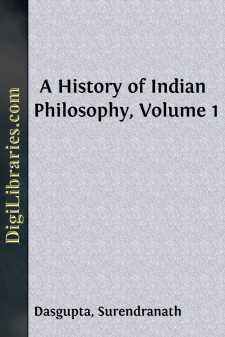Categories
- Antiques & Collectibles 13
- Architecture 36
- Art 48
- Bibles 22
- Biography & Autobiography 813
- Body, Mind & Spirit 142
- Business & Economics 28
- Children's Books 16
- Children's Fiction 13
- Computers 4
- Cooking 94
- Crafts & Hobbies 4
- Drama 346
- Education 46
- Family & Relationships 57
- Fiction 11829
- Games 19
- Gardening 17
- Health & Fitness 34
- History 1377
- House & Home 1
- Humor 147
- Juvenile Fiction 1873
- Juvenile Nonfiction 202
- Language Arts & Disciplines 88
- Law 16
- Literary Collections 686
- Literary Criticism 179
- Mathematics 13
- Medical 41
- Music 40
- Nature 179
- Non-Classifiable 1768
- Performing Arts 7
- Periodicals 1453
- Philosophy 64
- Photography 2
- Poetry 896
- Political Science 203
- Psychology 42
- Reference 154
- Religion 513
- Science 126
- Self-Help 84
- Social Science 81
- Sports & Recreation 34
- Study Aids 3
- Technology & Engineering 59
- Transportation 23
- Travel 463
- True Crime 29
A History of Indian Philosophy, Volume 1
Description:
Excerpt
CHAPTER I
INTRODUCTORY
The achievements of the ancient Indians in the field of philosophy are but very imperfectly known to the world at large, and it is unfortunate that the condition is no better even in India. There is a small body of Hindu scholars and ascetics living a retired life in solitude, who are well acquainted with the subject, but they do not know English and are not used to modern ways of thinking, and the idea that they ought to write books in vernaculars in order to popularize the subject does not appeal to them. Through the activity of various learned bodies and private individuals both in Europe and in India large numbers of philosophical works in Sanskrit and Pâli have been published, as well as translations of a few of them, but there has been as yet little systematic attempt on the part of scholars to study them and judge their value. There are hundreds of Sanskrit works on most of the systems of Indian thought and scarcely a hundredth part of them has been translated. Indian modes of expression, entailing difficult technical philosophical terms are so different from those of European thought, that they can hardly ever be accurately translated. It is therefore very difficult for a person unacquainted with Sanskrit to understand Indian philosophical thought in its true bearing from translations. Pâli is a much easier language than Sanskrit, but a knowledge of Pâli is helpful in understanding only the earliest school of Buddhism, when it was in its semi-philosophical stage. Sanskrit is generally regarded as a difficult language. But no one from an acquaintance with Vedic or ordinary literary Sanskrit can have any idea of the difficulty of the logical and abstruse parts of Sanskrit philosophical literature. A man who can easily understand the Vedas. the Upani@sads, the Purânas, the Law Books and the literary works, and is also well acquainted with European philosophical thought, may find it literally impossible to understand even small portions of a work of advanced Indian logic, or the dialectical Vedânta. This is due to two reasons, the use of technical terms and of great condensation in expression, and the hidden allusions to doctrines of other systems. The
2
tendency to conceiving philosophical problems in a clear and unambiguous manner is an important feature of Sanskrit thought, but from the ninth century onwards, the habit of using clear, definite, and precise expressions, began to develop in a very striking manner, and as a result of that a large number of technical terms began to be invented. These terms are seldom properly explained, and it is presupposed that the reader who wants to read the works should have a knowledge of them. Any one in olden times who took to the study of any system of philosophy, had to do so with a teacher, who explained those terms to him. The teacher himself had got it from his teacher, and he from his. There was no tendency to popularize philosophy, for the idea then prevalent was that only the chosen few who had otherwise shown their fitness, deserved to become fit students (adhikârî) of philosophy, under the direction of a teacher....


